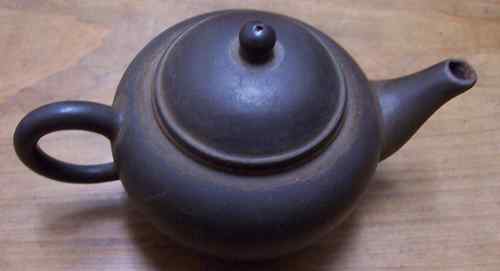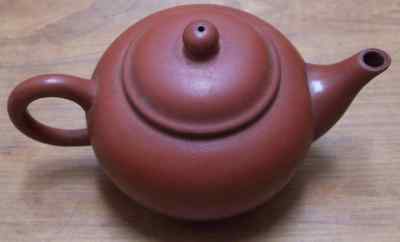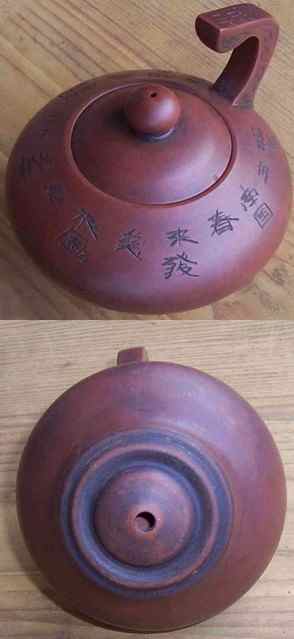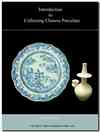The Role of Yixing Pottery
in Chinese Tea Culture
Yixing pottery has been part of Chinese tea culture for centuries. We
mention it here shortly for those collectors interested in teawares in
general.
During
the Tang and Song dynasties preparation of tea (tea brewing) was quite
different, and a coarse type of tea was used. The preparation for
drinking consisted mainly in grinding it with a pestle in a rubbing
movement inside a wide bowl with grooves down its inside. This is not
unlike the preparation of Lei Cha (Lei Tea) of the Hakka people today.
|
In those days mostly pewter teapots were used for the tea. At the same time as the quality of the tea itself improved over time in the Song dynasty, the use of pottery became also more and more frequent, and pottery teapots made of clay all but replaced pewter in China's tea culture. The western name of "Yixing" pottery comes from the location where the Zisha pots are made, the town of Yixing. It is located just near the western shore of Taihu, China's great lake, to the west of Shanghai. |
Today, many Chinese fond of drinking or brewing tea in the traditional
manner are avid collectors of "zisha", "tiesha" and "zhusha" teapots
from Yixing kilns.
Zisha (literally meaning "purple sand") is the name of a clay frequently used for Yixing pottery in the Chinese language.
Tiesha
literally means iron sand, due to its high iron content the clay is
very dark, almost black, and Zhusha is the more reddish type of Yixing
pottery clay. "Yixing" itself is the place name of the place where the
pottery has been made for centuries.
Yixing pottery is now mostly used for tea wares, both pots and cups, and some other tea paraphernalia.

This Yixing tiesha teapot has a greyish black color and
visibly has been in use for quite some time.
The clay color ranges from a reddish brown to a very dark brown
and greyish black. Basically, these Yixing pots and cups are all left
unglazed.

Zhusha teapots from Yixing kilns display a distinctly reddish clay
However, tea wares were not the only products of the Yixing kilns in the
distant past. Yixing wares include planters, brush washers and much
more. The latter are/were manufactured both in unglazed and glazed form.
In the Ming and Qing dynasties Yixing did also produce life-like
figurines, ceramic replica of walnuts, lotus kernels, lychees,
pomegranates, water caltrop and other produce, as well as crabs, coiled
sea shells, etc.
Later, during the Qianlong reign Jingdezhen followed suite and started also making such items using porcelain as material.
Yixing itself has a very long history. It first fired red pottery some
2000 years ago, during the Han dynasty. It is one one of the oldest kiln
sites still operating today!
|
Yixing Teapots
Yixing
teapots are handmade by individual artisans. Handmade means the body of
the pot is not thrown, the clay is shaped into perfect form by
craftsmen and women with simple tools.
Most Yixing wares remain unglazed. However, in the 19th and 20th
centuries at least some teapots and other items were covered with a
brightly colored glaze on the outside. Sometimes even the interior is
glazed. In such cases the clay peculiar to Yixing wares is only visible
at the unglazed foot or top rim. |
 |
Terminology in modern Chinese tea culture
Modern tea culture enthusiasts call teapots made of Yixing pottery clay living pots, and rubbing it is called "keeping the pot" (as one "keeps" a pet)... Other types of teapots are called "dead" pots.
With
the former, after tea drinking is finished the tea leaves are removed
from the pot, but the pot itself is not cleaned inside. Instead, it is
flushed with water and left to dry. The outside of the pot is rubbed dry
with a cloth. This is also done frequently when the teapot is not in use, even with new, yet unused ones. They call this "keeping the pot".
After doing this for a long time a thin layer of tea residue forms on the inside of the pot and some of the tea is able to penetrate the pores of the clay. Due to this, merely adding hot water without any tea leaves can flush out these tea residues and produce drinkable tea without tea leaves, hence they are called "living" pots.
|
Remark: * This is done with new ones also. * A pot that has been "kept" a long time may command a better price, even if it was previously used. |
Teapots made of porcelain or other non-porous materials on the other hand are called dead pots.
Their vitreous surface layer cannot absorb tea residues.
Rubbing the teapot will usually increase a teapots' collecting value.
Unfortunately, depleted Yixing clay mines are affecting Yixing pottery
production. You have to be careful what you use to drink tea today. The
current situation might lead to a major shift from the use of Yixing
wares to porcelain in the future, although a new mining area for the
clay appears to have been opened farther north in China.
Currently, many Chinese already prefer drinking from decades old vintage pots rather than from new ones anyway.
Yixing Pottery - Warning!
|
According to revelations made by the Chinese media, part of today's Yixing teapots are made of fake Zisha clay that is said to be toxic. How large is this part? Due to depletion or near depletion of zisha clay some quarries mining zisha clay in the vicinity of Yixing were closed as early as 2000. Unfortunately, some manufacturers have resorted to using normal clay which is then colored with chemicals to make it look like real zisha clay. In any case, drinking tea prepared in such new Yixing teapots or cups should be avoided as the chemically treated clay may be harmful. For more information, please ask via blog or, if you speak Chinese, the relevant information can be found directly on the Chinese internet. |
| 2015New information, if reliable, may mean that in future non-toxic teapots again may become available - only that the clay is not from Yixing. It appears that in the northeastern part of China new sources of this clay were found. |
Read more about Chinese Tea Culture
Home » Yixing Pottery » Teapot Marks

